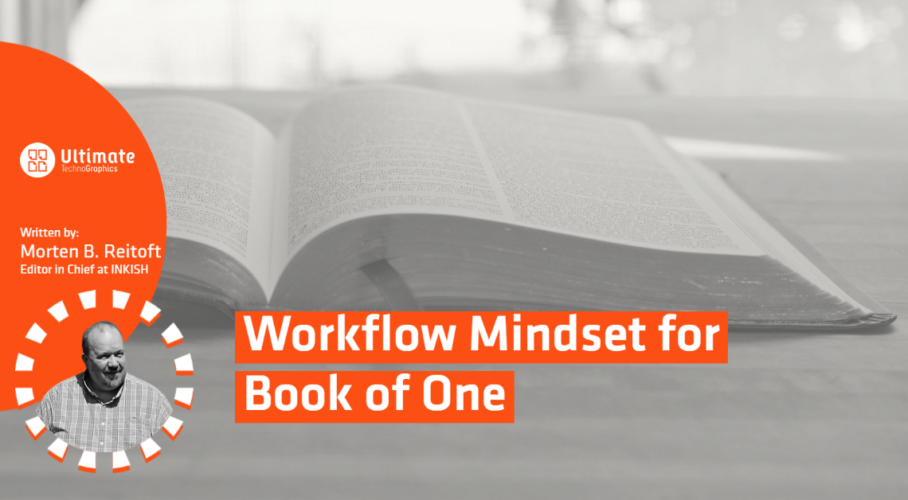Friends and followers. We are back with hopefully yet a great Ultimate TechnoGraphics blog post. My name is Morten B. Reitoft, and I am the editor of INKISH.
Years ago
Years ago, I heard about a company that wanted to sell books of one. It was back in the early 2000s, and I was intrigued by the idea, or that I was, until I ordered one. The price was high, the time from order to delivery was a bit too long, and the book quality I got was not good enough. At the time, the cover was in color (no lamination or other finishing), and the content was black and white. The binding was made with hot glue, which meant (at the time) yellow glue and pages that could easily be torn out of the book.
Being a first-mover is not always the easiest, and the story above only describes some of the potential pain points of book-of-one. Today more and more PSPs are offering book-of-one production, but before looking at the workflow, let’s look at the business case.
The misunderstanding
One of the common misunderstandings when I talk to printers who consider Books-of-One, is that printing a book-of-one is way more expensive than printing hundreds or thousands of books, and if you only look at the production cost, you might be right. However, you must first consider the value you create rather than the production itself. With the production of one, you eliminate warehouse costs. You also eliminate the costs of non-sold copies but even more important, you can offer sales of back catalogs which extends the so-called long tail.
By the way, I warmly recommend you to read The Long Tail by Chris Anderson, who so brilliantly describes the long tail. What is interesting for book producers is that the back catalogs may have a higher total volume than all the more recent books combined, opening up a new potential for printers who can offer book-of-one production, but that requires a production prepared for this.
Understand your business
A book-of-one production should be based on a solid understanding of the business. The conventional sales organization must be changed. You can’t “sell” books of one – salespeople will be selling solutions that deeply integrate with the publishers and their distributors. Still, you will also need to integrate with online resellers, where Amazon is just one of many. You will also need to consider your production workflow. Many printing companies today have pre-press departments, but you won’t be able to handle orders manually in the future. Your administration also needs to adapt, as all invoicing will need to be done automatically, and so will many other processes.
If you operate a conventional printing company, you will need to either dramatically change it or build an online presence side by side, but even to consider selling books-of-one without a streamlined workflow and organization is not an option.
On the production side, you will need a strategy whether you build everything around roll-to-roll or cut-sheet production. Both production types have advantages and disadvantages. I have visited both types, and each always cherishes the kind they’ve picked! But let’s pin some of the considerations:
• Cut-sheet makes it faster and easier to change substrate!
• Roll gives you lower paper prices
• Cut-sheet has fewer engine options (for now, at least)
• Roll gives you many options
• Cut-sheet allows you to use existing binding equipment if you have a conventional offset printing company
• Roll can deliver high-speed, high-quality, tailored products.
• Roll also provides cut sheets as an option.
Finishing
You will also need to consider your bindery. Do you want inline or nearline solutions? If you produce many of the same products, it makes sense to have inline finishing, as you get finished products delivered directly from the production line. Today it’s possible to get print and binding that enable book production of both hard- and software, with a variable format and spine size.
Product diversification vs pricing
There are, of course, many more considerations when entering into the books-of-one production, but in general, this is a very lucrative business as the pricing models are entirely different from offset. You will, however, need volume to be profitable, and that’s why you can combine, i.e., book production with other types of production. I have made a few films from an Italian book-of-one printer that also prints transactional/transpromo for customers and utilizes the equipment as much as possible. Still, it seems that all the books-of-one production companies I’ve visited are successful and have a clear view – or even a digital mindset, I would say.
One of the truly unique things I have realized visiting books-of-one PSPs is that many have an extended appetite for further one-to-one services. That includes digital services online, digital embellishments, personalized letters in the packaging, and the production of customized boxes.
Print is Alive!
Print is by no means dead or even dying – it’s a striving business with so many opportunities, but as with everything, it comes down to your mindset and ability to execute. Have fun. It is fun!
Morten B. Reitoft
Editor-in-Chief
INKISH

